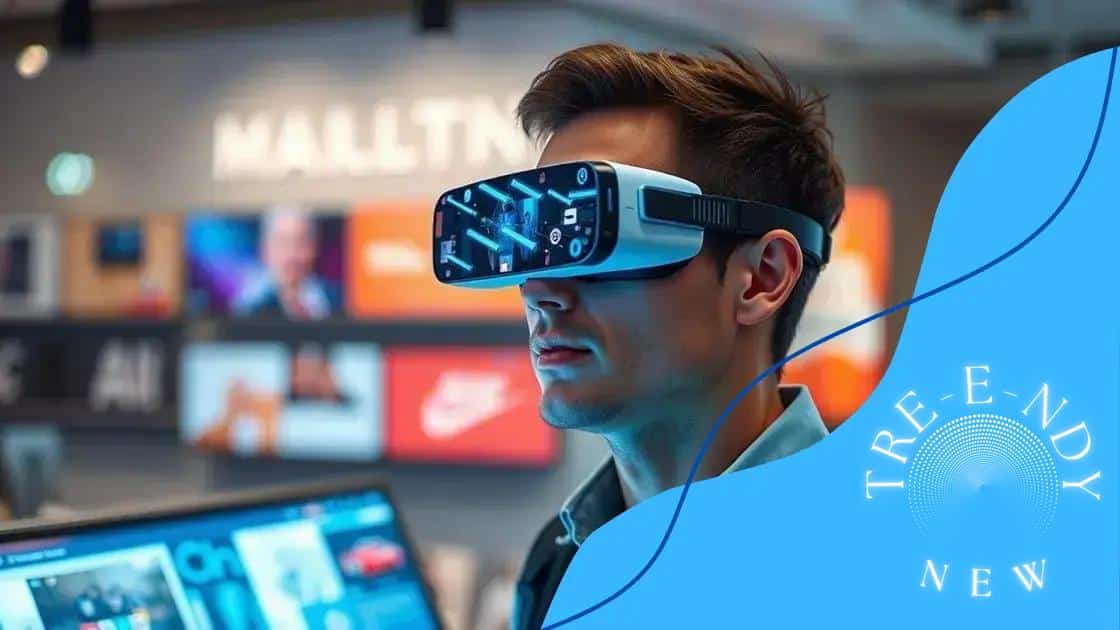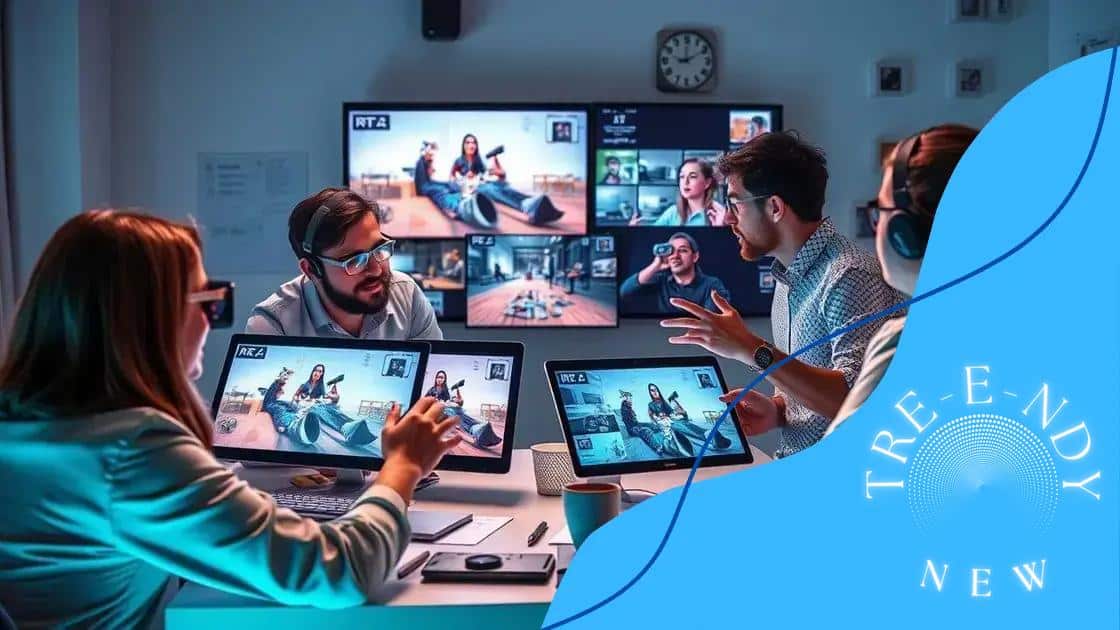Augmented reality marketing campaigns that engage customers

Augmented reality marketing campaigns significantly enhance consumer engagement, improve decision-making, and increase sales by providing interactive experiences that allow customers to visualize products in real time.
Augmented reality marketing campaigns are changing the landscape of brand engagement. Have you ever imagined how an immersive AR experience could reshape consumer perception? Let’s dive into what makes these campaigns so appealing.
Understanding augmented reality in marketing
Augmented reality (AR) is a powerful tool in marketing that enhances the customer experience by blending the digital and physical worlds. Understanding how AR works and its potential benefits can help brands create engaging campaigns that captivate their audience.
What is Augmented Reality?
Augmented reality superimposes computer-generated images, sounds, or other sensory inputs onto the real world. This technology allows consumers to experience products in a new way, leading to more informed decisions.
Benefits of Augmented Reality in Marketing
- Enhanced Engagement: AR captures attention and keeps customers interested.
- Improved Customer Experience: It allows for virtual try-ons and product demonstrations.
- Increased Brand Awareness: Unique AR experiences can go viral, expanding reach.
By integrating AR into marketing strategies, brands can create memorable interactions. For example, consider how a furniture store can let customers visualize how a couch looks in their living room using AR apps. This integration not only helps in decision-making but can also evoke emotional responses, making the experience personal.
Furthermore, businesses can gather valuable insights based on user interactions with AR content. This data can help refine future marketing efforts and enhance overall strategy.
In summary, understanding how augmented reality can be used in marketing opens doors to innovative ways to connect with customers, improve their experience, and ultimately drive sales. Implementing AR strategies is not just a trend; it’s a step towards future-proofing a brand in a competitive market.
Benefits of using augmented reality campaigns
Utilizing augmented reality (AR) campaigns offers numerous benefits that can significantly impact marketing strategies. Brands can enhance their customer interactions and create memorable experiences that stand out in today’s competitive market.
Increased Customer Engagement
One of the key benefits of augmented reality campaigns is the boost in customer engagement. AR allows users to interact with products in a fun and immersive way. By providing an engaging experience, brands can keep potential customers interested and encourage them to explore more.
Enhanced Product Visualization
AR empowers consumers to visualize products before purchasing. For example, a customer can see how a piece of furniture would look in their home or how a pair of shoes fits. This visual confirmation leads to more confident buying decisions.
- Visualization tools: Brands can use AR to give real-world context to their products.
- Interactive experiences: By using AR, customers can engage more deeply, leading to higher conversion rates.
- Memorable interactions: Unique AR experiences often stick in the customers’ minds, leading to brand loyalty.
Moreover, AR campaigns can create a sense of excitement and novelty. Consumers are more likely to share their experiences on social media, which can amplify a brand’s reach. As users share their AR interactions, they generate valuable organic marketing for the brand.
Data Collection and Insights
Using AR allows businesses to gather insights about consumer preferences and behaviors. By tracking how users interact with AR features, brands can tailor future campaigns more effectively. This data-driven approach increases the chances of success for subsequent marketing efforts.
The benefits of using augmented reality campaigns are substantial. From enhancing engagement to providing useful insights, AR has the potential to transform the marketing landscape. As brands adapt to new technologies, leveraging AR can create unforgettable experiences that resonate with consumers.
Best practices for creating AR experiences

Creating effective augmented reality (AR) experiences requires careful planning and execution. Understanding the best practices can help marketers build campaigns that resonate with consumers and drive engagement.
Know Your Audience
Before developing an AR experience, it is essential to understand the target audience. What do they enjoy? What engages them? By gaining insights into consumer preferences, brands can tailor their AR content to meet specific needs.
Set Clear Objectives
Every AR campaign should have clear goals. Whether it’s increasing brand awareness, driving sales, or improving customer loyalty, having defined objectives helps steer the project. Setting measurable outcomes ensures the effectiveness of the AR experience.
- Brand Engagement: Strive to create a memorable interaction that encourages customers to share their experiences.
- Education: Use AR to explain complex products in a simple and engaging way.
- Fun and Entertainment: Adding game-like elements can make the experience enjoyable, motivating users to return.
Moreover, the design of the AR experience should be intuitive. Users should not struggle to understand how to interact with the content. Clear instructions or prompts can enhance user experience significantly.
Test and Iterate
Once the AR experience is created, rigorously testing is crucial. Feedback from users can reveal what works and what doesn’t. Adjustments can be made based on these insights to improve the overall experience.
Incorporating analytics tools also provides valuable data to help assess user engagement and interactions. Brands can use this data to refine their approach and continuously enhance the AR experience.
By focusing on these best practices, brands can create AR campaigns that not only capture attention but also foster meaningful connections with consumers.
Examples of successful AR marketing campaigns
Examining successful AR marketing campaigns provides valuable insights into how brands can effectively engage consumers. These campaigns showcase creative ways to utilize augmented reality while driving brand awareness and sales.
Sephora’s Virtual Try-On
Sephora uses AR technology to allow customers to virtually try on makeup. This feature is available in their mobile app, enabling users to see how different shades of lipstick or eyeshadow look on their faces without visiting a store. The success of this campaign highlights how AR can enhance the shopping experience.
IKEA Place
The IKEA Place app revolutionizes furniture shopping by letting customers visualize how furniture pieces would look in their homes. Users can select a piece of furniture and place it in their space using their device’s camera. This interactive experience helps consumers make confident purchasing decisions.
- Positive user engagement: Customers enjoy the ability to see items in their own environments.
- Increased sales: By visualizing products, customers are more likely to complete their purchases.
- Community sharing: Users often share their AR experiences on social media, amplifying word-of-mouth marketing.
Moreover, companies like Pepsi have also ventured into AR marketing with their innovative bus shelter campaign. By transforming a standard bus stop into an interactive AR experience, Pepsi created a buzz that captivated passersby and encouraged sharing online. Such campaigns not only grab attention but also enhance brand recognition.
Pokemon Go’s Immersive Gameplay
While a game, Pokemon Go is an exemplary case of AR in marketing. The game encourages players to explore real-world locations to catch virtual characters. This effectively blended gaming with exploration, driving revenue for both the game and the locations participating in the promotional activities.
Insights from these successful campaigns reveal that the key to engaging customers lies in providing an experience that merges convenience with fun. As brands continue to explore AR, they can learn from these examples to create their own standout experiences.
Evaluating the impact of AR on consumer behavior
Evaluating the impact of augmented reality (AR) on consumer behavior reveals important trends and insights. AR transforms how customers interact with brands, making shopping more interactive and engaging. Understanding these impacts gives businesses a competitive edge.
Enhanced Decision-Making
AR technologies allow consumers to visualize products in their environment before making a purchase. This capability leads to more informed decision-making. For example, a customer using an AR app can see how a piece of furniture fits within their home. Such experiences reduce uncertainty and increase confidence in buying.
Increased Engagement and Enjoyment
AR not only enhances decision-making but also boosts overall engagement with the brand. Consumers find AR features enjoyable and are more likely to spend time exploring them. Engaging experiences can lead to longer browsing times and increased chances of purchase.
- Attention capture: AR grabs customer attention more effectively than traditional ads.
- Shareability: Fun AR experiences encourage users to share on social media, increasing brand visibility.
- Emotional connections: Powerful visual experiences can forge stronger emotional ties between brands and consumers.
Moreover, AR influences impulse buying. When consumers experience products through AR, they may be more likely to make spontaneous purchases. This immediate gratification can be enticing, leading to higher sales volumes.
Gathering Consumer Insights
Brands can also use AR technologies to gather valuable data on customer preferences and behaviors. Insights gained from how users interact with AR content can shape future marketing strategies. Tracking metrics like time spent on AR experiences or products viewed can guide businesses in refining their approaches.
In summary, evaluating the impact of augmented reality on consumer behavior highlights its role in enhancing decision-making, increasing engagement, and driving sales. As AR technology advances, its influence on shopping experiences will likely continue to grow.
FAQ – Frequently Asked Questions about Augmented Reality Marketing
How does augmented reality improve customer decision-making?
Augmented reality allows customers to visualize products in their own environment, helping them make more informed and confident purchasing decisions.
What are the benefits of using AR in marketing campaigns?
Using AR increases customer engagement, enhances the shopping experience, and can lead to higher sales through interactive and enjoyable interactions.
Can AR lead to impulse buying?
Yes, AR can encourage impulse buying as it provides immediate and engaging experiences that captivate customers and motivate them to purchase.
How can brands gather insights from AR campaigns?
Brands can track user interactions with AR experiences to collect valuable data on preferences and behaviors, helping refine future marketing strategies.





